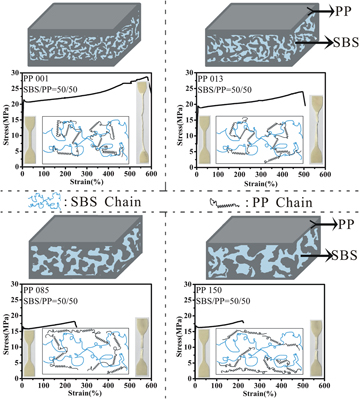Article contents
Sandwich-structure styrene-butadiene-styrene block copolymer (SBS)/polypropylene (PP) blends: The role of PP molecular weight
Published online by Cambridge University Press: 12 March 2019
Abstract

The effect of polypropylene (PP) molecular weight on the properties of styrene-butadiene-styrene block copolymer (SBS)/PP blends was studied. All SBS/PP blends (50/50 and 90/10) exhibited a sandwich structure where the co-continuous SBS/PP layer was between the top and bottom PP layers. Solvent extraction tests suggested that the continuous phase structure of PP was independent of the blending ratio and PP molecular weight, while the SBS phase changed from a dispersed phase to a continuous phase as the SBS content increased. The decrease in PP molecular weight decreased the PP layer thickness but increased the phase domain size of SBS in SBS/PP(50/50) blends. As a result, less noticeable “stress-hardening” phenomenon was observed. The mechanism for the structural change was attributed to the different melt viscosities of each component. The crystallinity of the blends did not change with the variable PP molecular weight but decreased with the increasing SBS content.
Keywords
- Type
- Article
- Information
- Copyright
- Copyright © Materials Research Society 2019
References
- 4
- Cited by


